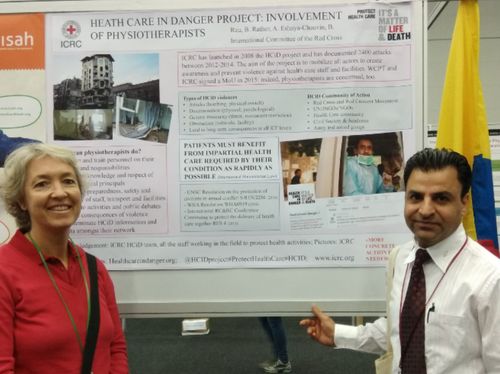
Aijaz Rather (right). ©ICRC
Physical therapists and other related specialists came together last month for a World Congress organised by World Confederation for Physical Therapy (WCPT) in Cape Town, South Africa 2-4 July 2017. The distinctive interactive forum offered an opportunity to learn about the modern scientific and clinical progresses made in the field of physical rehabilitation. Aijaz Rather, who works on the Physical Rehabilitation Program at the ICRC New Delhi Regional Delegation, writes about his experiences and exchanges at the Congress.
______
Around 2,000 physical therapists from more than 100 countries participated in the World Congress. It was a great opportunity for me to hear from experts in various fields related to physical therapy. The experts shared their latest findings as well as spoke about professional experiences gained during the course of their work in diverse contexts and conditions reflecting low, middle and high technological resource settings.
The broad interdisciplinary event featured symposia, instructional courses, exhibitor workshops, power points and poster presentations. It was an enriching experience for me and my colleagues from other ICRC delegations across the globe who were at the Congress.

The aim of this poster was to underline that older children having neglected clubfoot can also be treated conservatively. ©ICRC
Treating clubfoot effectively – A case study
In Jammu and Kashmir, the ICRC’s Physical Rehabilitation Program supports persons with disabilities by providing material and technical support to the Government Medical College Artificial Limb Centres in Jammu and Srinagar and the Prosthetics and Orthotics Workshop of Voluntary Medicare Society in Srinagar. The ICRC, along with Cure India, has provided support to more than 450 children in J&K. Our case study on clubfoot from J&K was submitted to the International Scientific Committee (ISC) of the WCPT where I made a presentation on it.
It is about an 11 year old child born with bilateral clubfoot. He was treated conservatively using Ponseti method – which includes application of serial casts, tenotomy followed by bracing. After three months of rigorous treatment and follow-up, the child has shown considerable improvement. Our support in this particular case was appreciated at the event.
My presentation included a poster which aimed to underline the fact that older children having neglected clubfoot can also be treated conservatively.
I also got to know more about the activities of various institutions working on physical rehabilitation and learned about new products and pioneering technological advancements made in the field which I am sure will help me in improving quality care of persons with disabilities.
Note to editors:
The WCPT and the ICRC signed a memorandum of understanding in 2014 agreeing that the two organisations will work together to address violence against patients and health workers (health care in Danger, HCiD).
Read more.
Follow us on Twitter @ICRC_nd.


